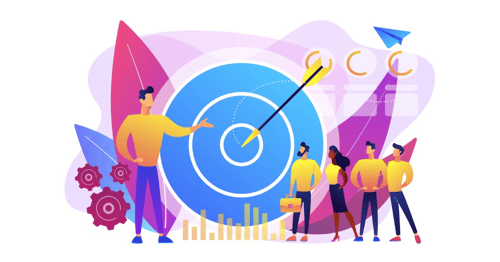Related Articles

Team Kissflow
Updated on 21 May 2025 • 5 min read
Everything that is done in an organization to recruit, retain, reward, develop, and make employees perform better is a part of the talent management process. Hiring and retaining top talent can be incredibly difficult for businesses, but creating an optimized talent management strategy can make the entire process more streamlined and effective.
In fact, companies that implement strategic talent management processes are able to see a 38 percent higher employee engagement and 40 percent lower employee turnover.
Talent management process in an organization is about identifying vacant positions, hiring suitable candidates, developing their skills to match the position, and retaining them successfully in order to achieve long term organizational goals. Strategic talent management processes align with the organization’s business goals and enable the organization to sustain and stay relevant.
Talent management in human resource management (HRM) refers to the strategic approach employers use to attract, develop, and retain a highly productive workforce that is committed to the organization for an extended period. When executed effectively, this process can enhance the company's performance, streamline operations like expense management, and maintain its competitive edge.
Employees are the biggest asset to an organization, which is why sourcing the best talent is the top priority of businesses today—making tools like employee onboarding automation essential for ensuring a smooth transition and early engagement.
It includes identifying the human resource requirements, selecting the skills expected from the ideal candidate, developing an excellent job description, and proposing a complete workforce plan for recruitment.
You need to decide whether you want to fill the vacant position internally or externally. If there are already employees in your company who would be suitable for the job, then its best to fill the position internally. Hiring internally doesn’t just help your company save costs and time, but it also boosts employee morale and retains talent.
If there aren’t any suitable internal candidates who possess required skills, then you need to look outside and search for new candidates to initiate the onboarding process.
The selection step can have multiple stages based on the type of job and the number of candidates that have applied for it. The process may involve reviewing the best resumes, written tests, and face-to-face interviews. The final shortlisted candidate will then go into the negotiation phase to discuss his/her expected salary and benefits.
As the selected candidate joins the company and becomes an employee, his/her skills need to be developed according to the job responsibility. It usually starts with an onboarding program where new employees get accustomed to the work culture of the company. They also go through internal skill training to enhance their proficiency.
Just hiring the right talent and hoping they will perform their best work for the company in the long run doesn’t work. Organizations need to focus on employee retention strategies as well including rewards, increments, promotions, and providing growth opportunities to employees, both vertically and horizontally within the organization.
The last step of the talent management process is transitioning where employees leave the company and they are replaced by their newer counterparts. This can include conducting exit interviews and deciding who will replace them.
The talent management process within the organization needs to be as effective and seamless as possible to make sure when an employee leaves or joins a company, it has minimal effect on their team as a whole.
Optimizing the productivity of the talent management process starts right with the hiring strategy. After all, when you make smarter hires with strong potential in a swift manner, you can streamline company operations with minimum disruptions.
To make faster recruitments and still hire better talent, recruiters need to leverage the latest technological tools like application tracking system (ATS) or all-in-one human resource management system (HRMS).
Effective onboarding is just as important for increasing productivity within the organization. In fact, according to a report, when companies offer a seamless onboarding program to new hires, they can see a 54 percent increase in productivity.

Talent acquisition is about hiring the right candidates with the right skills who have the potential to evolve and perform well in the company. On the other hand, talent management is the end-to-end process of finding, selecting, hiring, training, and retaining talent. It also involves employee transitioning and exit process.
You need to support employees that are performing effectively in their current roles. The idea is to retain talent by helping them grow and making sure they are happy with their job role and responsibilities.
While it is easier to write off employees that are underperforming in the right role, it is important for organizations to consider all factors like poor training, lack of resources, poor role definition, and poor supervision before blaming it all on the employee.
Otherwise you might end up hiring the replacement with the exact same issue.
That is why you need to do what it takes to give your employees the right training programs and define their role more accurately.
There will always be a time when employees will outgrow their job roles. Organizations need to get the timing right and promote the employees before they get hired by a competitor. Employees often think they are ready for a promotion before you think they are ready. In cases like these, it is always better to move them before you are comfortable in order to retain talent.
When you see an employee underperforming, you need to analyse whether they are in the wrong role or the right role. If they are in the right role, then you need to invest in the employees. But if they are in the wrong roles, then you need to move them into a role that is more suited to them.
Instead of much-dreaded annual performance reviews, organizations are now moving towards an everyday performance approach that engages employees and supports work performance.
The idea behind it is to put less emphasis on past performance and more on developing future goals. It isn’t surprising that 76 percent of the organizations have already adopted continuous performance approach.
Over 58 percent of the employees want to learn at their own pace. While 94 percent of them say that they would have stayed longer in an organisation if it had invested more in their career development.
When it comes to corporate learning, organizations also need to remember that adopting a one-size-fits-all approach doesn’t work anymore. Instead, they need to create personalised learning path for employees to develop their current and future roles.
With the help of streamlined tools, the entire talent management process is becoming more and more transparent. By openly publishing job opportunities and asking employees to apply themselves or refer someone who they feel is right for the job, organizations can create a more transparent and open work environment.
The entire talent management process can become even more streamlined if you have the right human resource management tool to manage and track all the required HR processes and projects.
Kissflow HR Cloud offers companies with a unified interface to support all critical talent management needs. From recruitment to onboarding, employment management, corporate training, performance reviews, and offboarding, you can manage all human resources-related work within the same HR tool.
Get started with the Kissflow Platform and learn how to leverage its features to drive better results
Related Articles
Welcome.
Let's get started.
To begin, tell us a bit about yourself
By proceeding, you agree to our Terms of Service and Privacy Policy
"The beauty of Kissflow is how quick and easy it is to create the apps I need. It's so user-friendly that I made exactly what I needed in 30 minutes."
Oliver Umehara
IT Manager - SoftBank
A Trusted Choice for Companies Globally




Thank you for signing up
Someone from our team will contact you soon.

Know why all the IT leaders converging at booth #602
Earn a chance to be part of our experience event

Get the first look at the 2024 Citizen Development report
Welcome.
Let's get started.
By proceeding, you agree to our Terms of Service and Privacy Policy
Wondering where to start?
Let's talk!
Connect with our solution experts to gain insights on how Kissflow can help you transform ideas into reality and accelerate digital transformation

This website uses cookies to ensure you get the best experience. Check our Privacy Policy


